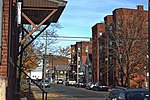Air Force Special Projects Production Facility
1961 establishments in Massachusetts1976 disestablishments in MassachusettsInstallations of the United States Air Force in Massachusetts

The Air Force Special Projects Production Facility was a top-secret facility operational at Westover Air Force Base from 1961 to 1976. It was responsible for developing film from the Corona satellite program and other film projects that were top secret. The facility was co-located with the 8th Reconnaissance Technical Squadron and developed the film used during the Cuban Missile Crisis. It was also the primary production facility for the National Reconnaissance Program during this time. The facility was also in charge of the Controlled Range Network, which served to calibrate Corona, Gambit, and Hexagon satellite programs.
Excerpt from the Wikipedia article Air Force Special Projects Production Facility (License: CC BY-SA 3.0, Authors, Images).Air Force Special Projects Production Facility
Starlifter Avenue, Chicopee
Geographical coordinates (GPS) Address Nearby Places Show on map
Geographical coordinates (GPS)
| Latitude | Longitude |
|---|---|
| N 42.20015 ° | E -72.546258333333 ° |
Address
Starlifter Avenue 100
01022 Chicopee
Massachusetts, United States
Open on Google Maps





